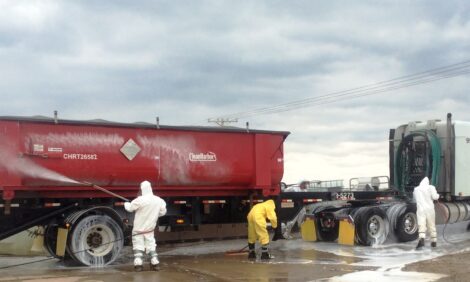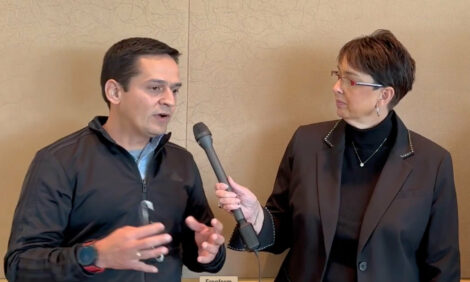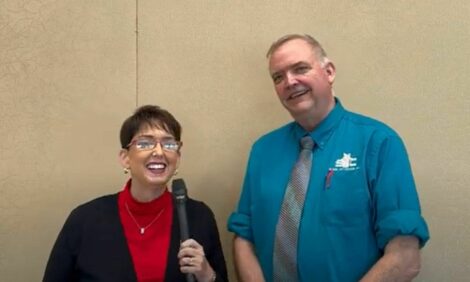



Leman Swine Conference: Controlling PEDV with bioexclusion, biocontainment and biomanagement
Biosecurity is key to preventing PEDV, but what happens once you have it?Part of Series:
< Previous Article in Series
Biosecurity is made up of three components: bioexclusion, biocontainment and biomanagement, according to Karine Talbot, DVM, HyLife Ltd, Canada.
- Bioexclusion is the most well-known: external biosecurity, all the steps taken to prevent infectious diseases from entering the herd.
- Biocontainment is all the steps taken to prevent infectious diseases from getting out of an infected barn and spreading to others.
- Biomanagement is internal biosecurity. It is all the steps taken to prevent (or minimize) infectious diseases from spreading from infected pigs to non-infected pigs within the same barn.
In the fight against the porcine epidemic diarrhea virus (PEDV), all three biosecurity components are needed. PEDV is a different beast when it comes to biosecurity; it is extremely infectious and contagious, and very little is needed to infect a naive barn. If strong bioexclusion and biocontainment are not in place ahead of an outbreak, PEDV can spread like wildfire, Talbot said during the 2023 Leman Swine Conference.
The level of bioexclusion implemented is often based on a risk versus impact approach per barn. Boar studs, multipliers and sow barns usually have a higher level of bioexclusion protocols to protect them from diseases, she said.
But in a pig-dense area, does it still make sense to have low biosecurity levels in certain herds? If a finishing barn near a large sow barn breaks with PEDV due to poor biosecurity protocols, it will increase the risk for that sow barn, no matter how good the bioexclusion protocols are, Talbot emphasized.
To control diseases like PEDV, every barn must have good biosecurity measures in place. Biocontainment is also key to protecting others against PEDV. Everything coming out of the herd becomes a potential risk to spread PEDV to others: people, tools and equipment, trucks and trailers, but also pigs.
Biomanagement
Talbot asked some difficult questions:
- Where are these PEDV positive pigs going to be placed?
- Close to which barn?
- Whose barn?
With PEDV (and many other diseases), it is never a “single herd problem,” she said. One producers’ disease management decision will impact the neighbors around them. Where the PEDV positive pigs will be moved to affects the swine industry in general. There are cross-contamination risks for feed mills, livestock trailers, cull sow assembly yards and slaughter plants, she added.
Other key elements of a complete biosecurity program are health monitoring (surveillance) and sharing of information. To have a chance in the fight against PEDV, it is important to know which herds are positive (and not every case is obvious) by performing routine surveillance. That information must be shared between veterinarians and producers in the area. As the popular saying goes: “knowing is half the battle,” she said.
Biosecurity is more than just protecting a herd from what could come in (bioexclusion); what’s coming out (biocontainment) must also be considered. And to be successful in the fight against PEDV, both must be implemented in all types of herds (sow, nursery and finishing). It’s much easier to protect herds in an area where PEDV is not present.
New technologies
The swine industry has always undertaken a certain level of disease outbreak investigation. However, disease outbreaks were a rare occurrence and would not spread further than a few barns, usually from the same flow, Talbot said.
This changed significantly when PEDV arrived in North America in 2017, again in 2019 and more recently in 2021-22. Disease outbreak investigation requires time and effort to obtain as much accurate information as possible. Unfortunately, during a large-scale outbreak, time for investigation isn’t available, she emphasized.
The industry knew they had to do investigations much faster, not only to learn from our mistakes and how PEDV was entering the barns, but most importantly to prevent the next outbreak by stopping the spread and implementing proper biocontainment in farms at risk, Talbot said.
After a 6-month pilot project trying a geofencing and biosecurity software (Farm Health Guardian), they fully implemented the technology in spring of 2022 for all our locations (farms, feed mills, wash bays, slaughter plant, etc.) and enrolled our equipment and people; and that has been an incredible journey for our biosecurity and biocontainment, she explained.
Geofencing
A geofence is a virtual fence around a property. The software records all movement of registered devices (GPS in vehicles, a smartphone with the software app, etc.). The software then allows people with proper user access to see who visited their sites and run various reports, including trace-in / trace-out reports and maps.
Talbot explained that the implementation of geofencing software helped to:
- Get accurate and timely contact tracing during disease outbreaks (reduced from hours to minutes)
- Increase employee engagement by giving them a sense of ownership and knowledge about who is at their site
- Easily practice, train and audit disease outbreak scenarios using real data
- Present a visual tool for biosecurity processes and breaches
- Improve communication of an outbreak or barn under biocontainment
The original objective of implementing this software in our production system was to help with outbreak investigation and trace in and out movement, Talbot said. A biosecurity downtime chart is now included, and people can easily access it and quickly find how much downtime is required to visit sites, she added.
The app will “deny” people entry to a certain site if they do not have the proper downtime (and send an alert to the veterinary team).
The app can also add certain “rules” to only access certain sites. For example, a specific truck can be allocated to high health sites and an alert is sent if they are detected on a site not listed as “approved,” Talbot concluded.









